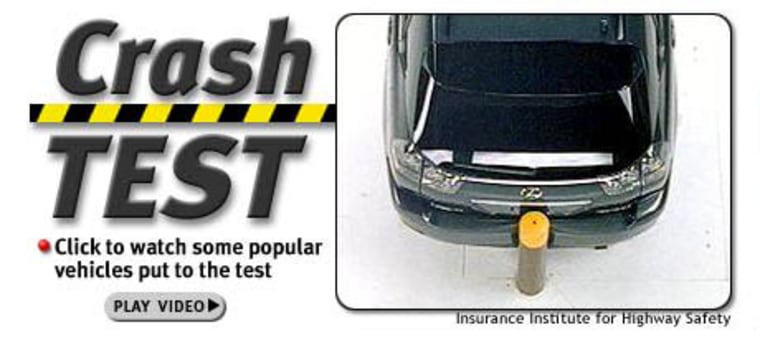Planning to hit the malls for some shopping this weekend? Just make sure you don’t hit anything else. It may not look like a little fender-bender does a lot of damage, but just wait till you get the bill. The results are in from the latest bumper crash tests of SUVs.
SUVs may be designed to drive up mountains, but in reality, you’ll more likely see them in traffic — and traffic is where fender-benders happen. So how do rough, tough SUVs fare in the urban jungle?
“When it comes to minor bumps, they’re anything but rough and rugged,” says Brian O’Neill, president of the Insurance Institute for Highway Safety. “They’re fragile.”
The Institute tests vehicle bumpers for the insurance industry, in an effort to keep repair costs and insurance claims low.
“We ought to be able to bump cars in low speed crashes without much damage,” says O’Neill.
The Institute selects vehicles to test, and judges them based on the total estimated repair cost from four bumper tests. Each test is just five miles per hour, a fast walking speed.
While the damage often doesn’t look like much on the outside, it’s what you can’t see, underneath, that can really ratchet up the costs.
“This kind of damage can drive up everybody’s insurance costs,” says O’Neill.
In this group, were nine new midsize SUVs, ranging in price from $24,000 to nearly $44,000.
First up, the 2003 Honda Pilot. In each of the five-mile-an-hour tests, the Pilot has about $400 of damage. Sounds pricey for such small bumps, but according to O’Neill, “This is actually pretty good, compared to its competitors. We would like to see better performance, but we settle for what we can get. And this is as good as it gets right now.”
The Honda Pilot gets the Institute’s second highest rating, acceptable.
And how about those competitors? Take the redesigned 2004 Lexus RX330. It may not look like much, but in the front angle test alone, it racks up over $1,600 of damage.
“The head lamp is driven backwards, inside,” says O’Neill. “You’ve got some separation here. This head lamp assembly’s driven back, damaged the fender.”
The bulk of the damage though is under that bumper cover
“This bumper bar doesn’t extend out here, to provide adequate protection in the corner,” says O’Neill. “Plus, instead of this bar being mounted with something that absorbs the energy without damage, it’s mounted on this frame member that’s crushed.”
The Lexus RX330 gets a marginal, the second lowest mark. So does the Nissan Murano, with over $1,200 damage, each in the angle and pole tests. And another marginal rating for the 2004 Mitsubishi Endeavor, with almost $1,000 of fixes in three of the four tests.
“Simple problems add up to expensive repair bills,” says O’Neill.
And five other SUVs tested got even lower grades, and higher repair bills.
The 2004 Kia Sorento had over $1,000 each in the flat tests, almost $2,000 in the angle test, and nearly $2,300 in the pole test.
“This bumper system is totally inadequate,” says O’Neill. “It doesn’t provide any protection.”
The Sorento gets a poor, the lowest rating. And so does the 2004 Cadillac SRX. There’s nearly $1,000 in the rear flat test, about $2,400 for the angle, and a huge $2,814 to fix pole damage. Remember the SUV is only going five miles an hour!
“It’s too many parts damaged, and too much to repair,” says O’Neill.
The 2003 Infiniti FX35, is also rated poor, with $800 to $2,000 in fixes for each test, as is the redesigned 2003 Toyota 4Runner, with about a $1,000 of damage in each of the four tests, and the Chrysler Pacifica, with over $2,800 in the pole test alone.
Manufacturers of the vehicles tested say their SUVs meet or exceed all federal safety regulations, and also say the cost of bumper repairs is just one of many considerations in designing a vehicle. And Nissan, which makes the Murano and the Infiniti FX35, questions whether the Institute’s tests accurately reflect real-world conditions.
Not every SUV did badly in every test, and O’Neill says most low speed crashes are unsightly rather than unsafe. But one bad bump could cost you a bundle.
